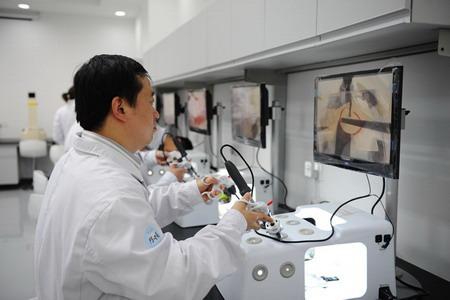
A researcher tests equipment at a Johnson & Johnson Shanghai Medical Science Center laboratory. Johnson & Johnson Medical (China) Ltd's two science centers have trained more than 35,000 Chinese medical care staff. [Provided to China Daily]
BEIJING - With the recent upgrading of its Shanghai medical science center, Johnson & Johnson Medical has committed itself to strengthening its support for the training of community and rural medical practitioners in China."It's our social responsibility to help China enhance its hospital service quality and expand medical care coverage, especially in some underdeveloped regions, as our business has been growing in the nation and with the nation for so many years," said Xie Wenjian, president of Johnson & Johnson Medical (China) Ltd.
The medical equipment giant set up two medical science centers in Shanghai and Beijing in 2001 and 2005 respectively. These are engaged in providing clinical training and international professional exchange opportunities for medical care staff around China.
Along with the deepening of China's medical care system reform, more focus is now being put on community and county-level hospital construction, a move to ease pressure on large hospitals and make available medical care services to more people.
"Johnson & Johnson is coordinating with government policy. Construction of a hospital involves the establishment of infrastructure and professional team-building. We can concentrate our efforts on the latter," said Xie.
The two science centers have been focusing on offering training for medical care practitioners in big hospitals at key cities, because the facilities and technologies used there are cutting-edge and most Chinese community and rural clinics do not have them.
Now that the government has decided to upgrade the infrastructure and equipment in those hospitals, staff training has become crucial to enable practitioners' capabilities to match the hardware improvement.
China announced in 2009 it would invest 850 billion yuan ($124 billion) in a reform of the medical care system within three years. It will add 24,000 community healthcare centers nationwide and upgrade 2,000 county-level hospitals by 2011.
Aiming to meet grassroot medical facilities' needs and deal with the ever-increasing chronic diseases caused by urbanization and aging in China, the upgraded academic center will attach more importance to six medical sectors: general surgery, cardio-thoracic surgery, urinary surgery, gynecology, orthopedics and cardiology.
"We will enforce our cooperation with local health and medical care departments to tailor our training for the medical institutes with various conditions," said Xie
A "One-company doctor training solution" involving comprehensive medical care knowledge and skills training for a professional doctor is to be provided in a practice-oriented model. "For example, our training for a doctor specializing in cardiovascular problems includes knowledge about diabetes because many of the patients may be diabetic," said Xie.
The gross area of the renovated Shanghai Johnson & Johnson Medical Science Center expanded 30 percent from the nearly 3,000 square meters in 2005, when it was established. The training capacity has doubled, the company said. The Beijing center's office area is about 6,000 sq m.
The two centers have trained more than 35,000 Chinese medical care staff at different levels. More than 80 percent of them are professional doctors and nurses. It helped provide a high-level medical care administrative program to increase management efficiency in large Chinese hospitals. The company has organized more than 2,000 international exchange events so far based on the platform of the two academic centers.
So far, Johnson & Johnson Medical has six such centers in the Asia-Pacific Region, in India and Japan.
"Those centers are part of our global training system, which is based on Johnson & Johnson's diversified business portfolio and international network. The system offers both globalized and localized professional training services and helps expand local medical care talent pools," said Xie.
He indicated that more such centers in China were under consideration without revealing details or the proposed investment.
"You can say the figure is very big, but I don't think money is the most important consideration," he said, adding that China was currently the fastest growing market for Johnson & Johnson Medical and its stable political situation and robust economic development made it lucrative for the company.
Analysts say that Johnson & Johnson Medical is nurturing the Chinese market through its training, citing that facilities and technologies used in the centers were all provided by the company.
But Xie said that training in the centers was comprehensive instead of purely an introduction to equipment usage, a task performed by the marketing staff of Johnson & Johnson.
"We are growing with China. We hope the nation will become stronger and stronger. It's our responsibility to make the nation better and then we can do better here," he added.
This year is the last year of the strategic cooperation program between the company, the Ministry of Health and the State Food and Drug Administration. The company said the cooperation was expected to continue and more investment would be forthcoming.





